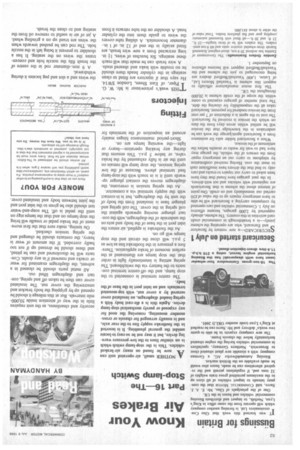Know Your Air Brakes
Page 54

If you've noticed an error in this article please click here to report it so we can fix it.
Part 16—The Stop-lamp Switch
BY HANDYMAN
ANOTHER small, air-operated unit can now be found on many air-braked vehicles. This is the stop-lamp switch which is on similar lines to the low-pressure warning device, but it may not be so easy to locate amidst the general plumbing. It is inserted in the footbrake supply line to the rear axle, and is usually arranged for chassis or crossmember mounting, removing the need for any exposed or purely mechanical stop-lamp device. Again this is a die-east body ivith a spring-loaded diaphragm, an insulated cover secured by a cover nut, with top-mounted terminals and an inlet port in the base of the body.
The centre terminal is connected to the stop lamp, and the off-centre terminal connects to the battery via the switchboard. The spring setting is intentionally light in order that the stop lamps are illuminated at the earliest moment of brake application. Therefore a pressure in the footbrake line as low as 5 p.s.i. will close the circuit and the stop lamps will go on.
As the footbrake is applied, air enters the inlet port in the base of the body and acts on the underside of the diaphragm, with the contact plunger moving upwards against the coil spring in the cover. The coil spring and plunger base is insulated from the body of the unit by the diaphragm, but is in contact with the supply terminal via a connector.
As the spring tension is overcome, the diaphragm moves the contact plunger upwards until it is in touch with the stop-lamp feed terminal above. Because of the low spring tension, the stop lamp will remain on until the air is fully exhausted by the brake valve, or below 5 p.s.i. This ensures that during any braking operation—heavy or light—the warning lamps are on.
Short-period maintenance hinges mainly around an inspection of the terminals for security and cleanliness, as the unit requires little in the way of attention inside 50,000mile intervals. But at this mileage it should be opened up by gripping the body bracket and unscrewing the cover nut. The insulated cover can then be taken off and spring, contact and diaphragm lifted out.
All metal parts should be cleaned in a solvent, the diaphragm examined for wear or cracks and renewed if in any doubt. Contacts will be discoloured and can be pitted, and these should be dressed up if not too badly corroded. If the amount of wear is heavy, the contacts should be changed and the spring tension checked.
On testing, make sure that the first movement of the brake pedal or treadle will bring the stop lamps on and that the lamps sty on until the pedal is off. The soap-and-water test should also be given to the inlet port and the joint between body and insulated cover.




























































































































